Superhydrophilic porous carbon foam as a self-desalting monolithic solar steam generation device with high energy efficiency†
Abstract
The main challenge relating to interfacial solar steam generation (ISSG) for desalination is salt accumulation on solar absorber surfaces, which significantly decreases the evaporation efficiency. The most common method to overcome this issue is the design of a hydrophilic/hydrophobic multilayer composite system, where the upper hydrophobic layer is used for light absorption and the lower hydrophilic layer is used for pumping water. Obviously, such a complex multilayer system results in unsatisfactory efficiency and high cost solar desalination. Here, we propose a novel strategy to address this issue, with self-floating superhydrophilic porous carbon foam (SPCF) used as an integrative solar absorber for desalination, utilizing the powerful water pumping capabilities of SPCF. Salt from bulk water can be quickly re-dissolved in the 3D porous structure of SPCF, and no salt accumulation was observed on the surface of SPCF in simulated seawater during 8 h of desalination. Together with superior light absorptance (96.19%), an ultrafast solar-thermal response (a temperature increase of 92.7 °C within 10 s under 2 sun), low thermal conductivity and outstanding mechanical robustness, a high energy efficiency (86% at 1 sun) and simultaneous salt resistance during vapor generation are achieved. These findings provide a new approach for designing self-desalting monolithic ISSG devices to satisfy the demand for eco-friendly, low cost, highly efficient, and robust solar desalination.

- This article is part of the themed collection: Journal of Materials Chemistry A Lunar New Year collection 2021


 Please wait while we load your content...
Please wait while we load your content...